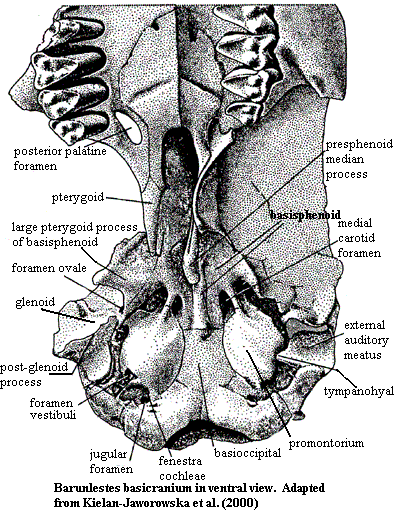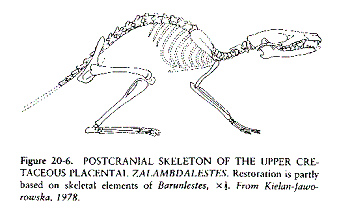
| Palaeos |  |
Eutheria |
| Vertebrates | Eutheria |
| Page Back | Unit Home | Unit Dendrogram | Unit References | Taxon Index | Page Next |
| Unit Back | Vertebrates Home | Vertebrate Dendrograms | Vertebrate References | Glossary | Unit Next |
|
Abbreviated Dendrogram
MAMMALIA |--METATHERIA `--EUTHERIA `--+--Eomaia `--+--Zhelestidae `--+--Asioryctitheria `--+--Zalambdalestidae `--+--Leptictida `--PLACENTALIA |
Contents
Contents
Overview |
Taxa on This Page
 Zalambdalestidae, Anagaloidea and Fashion Statements
Zalambdalestidae, Anagaloidea and Fashion StatementsThe zalambdalestids recently have acquired the status of indispensable accessories to a fashionable mammalian pedigree. They are included among the Anagalida, as close cousins to rabbits, rodents and elephant shrews. They are traditionally referred to the Insectivora, as proto-shrews; and they are frequently mentioned in the same breath with zhelestids as early ungulatomorphs. At the same time they are claimed by some very chic basal eutherian clans as asioryctotherians or even leptictidans. This is all a bit odd because no one seems to have paid any serious attention to the anagaloids, who are evidently close connections, since Malcolm McKenna's work in the 1960's and 1970's. See, e.g., McKenna (1963). Perhaps the Paleocene to Eocene anagaloids simply come too late to be of much interest. Otherwise, it is hard to ascribe this discrimination to anything but scientific fashion.
The zalambdalestids are attractive as rabbit or macroscelidan ancestors since they are clearly jumping animals, and had an elongated rostrum quite possibly supporting a proboscis similar to those of elephant shrews. Unfortunately zalambdalestids are both too early and too primitive to be near the direct line of descent. More likely, they simply illustrate a precocious development of some of the design possibilities inherent in the eutherian plan. ATW021105 040118
Update: The current consensus is that zalambdalestids are stem eutharians after all, and hence outside the placental crown group (Wible et al. 2009, Giallombardo 2009). Similarities with macroscelidans and anagalida, or even leptictidans, are likely the result of convergence MAK1207138
 Zalambdalestidae:
Alymlestes, Barunlestes, Kulbeckia, Zalmbdalestes
Zalambdalestidae:
Alymlestes, Barunlestes, Kulbeckia, Zalmbdalestes
Range: middle Cretaceous or Late Cretaceous of Mongolia and Central Asia
Phylogeny: Eutheria ::: Adapisoriculidae + (Zhelestidae + (Asioryctitheria + Cimolestidae) + ((Leptictida + Placentalia) + *)).
Characters: elongated snout largely due to growth of maxilla, but with
some contribution from premaxilla [A+01]; maxilla extends posteriorly along
choanae [K+00]; postglenoid process extends only along medial portion of glenoid
glenoid fossa [L+01]; occipital plate inclined anteriorly from the condyles
[K+00]; braincase more inflated and the "mesocranial region" (between
palate & otic capsules) is shorter than in asioryctitherians, but longer than
modern placentals [C88] [K+00]; promontorium
flattened [K+01]; carotid foramen is medial (lateral in living mammals) [K+01];
basisphenoid with prominent pterygoid process [K+00]; cerebellum short &
wide [C88]; presphenoid with prominent
median process [K+00]; neocortex probably very small [C88]; dental formula variable, generally
trending to reduced formula of Glires [A+01]; large, medial, procumbent and
ever-growing ("open-rooted")
lower incisors [A+01] [FK02]; incisors with enamel restricted to outer surface
(or at least asymmetrically distributed on outer surface) and near the crowns [A+01]; I1
not enlarged [FK01]; i1 incisor  oval in cross-section [FK01]; i1 roots extend to
level of m1 (Barunlestes) [FK02]; i1 roots particularly thin-walled with
large pulp cavity [FK02] i1 straight and procumbent, not curved upward as in
Glires [FK02] axis with long spinous process [3] [K+00]; atlas
intercentrum fused to neural arch [C88]; thoracic
vertebrae with short spinous processes [K+00]; scapular spine present [C88]; no
separate coracoid or interclavicle [C88]; tibia & fibula strongly fused
[K+00]; astragalus with tibial trochlea well developed [K+00]; astragalus fully
proximal to calcaneum [C88]; hind limbs and
metatarsals very long [K+00]; strongly adapted for reliance on olfaction and
hearing, probably nocturnal [K+00].
oval in cross-section [FK01]; i1 roots extend to
level of m1 (Barunlestes) [FK02]; i1 roots particularly thin-walled with
large pulp cavity [FK02] i1 straight and procumbent, not curved upward as in
Glires [FK02] axis with long spinous process [3] [K+00]; atlas
intercentrum fused to neural arch [C88]; thoracic
vertebrae with short spinous processes [K+00]; scapular spine present [C88]; no
separate coracoid or interclavicle [C88]; tibia & fibula strongly fused
[K+00]; astragalus with tibial trochlea well developed [K+00]; astragalus fully
proximal to calcaneum [C88]; hind limbs and
metatarsals very long [K+00]; strongly adapted for reliance on olfaction and
hearing, probably nocturnal [K+00].
Note: [1] according to [FK02], it is not clear that the i1 of Zalambdalestidae is homologous with the i1 of Glires. [2] see image above for braincase features. [3] this process is just visible on the skeletal reconstruction. A similar structure is present in ricochetal rodents. It limits the mobility of the cervical vertebrae and stabilizes the neck for jumping [C88]. ATW021105.
Comment: retention of epipubic bones shows that Zalambdalestids had not yet achieved the prolonged gestation characteristic of placentals (Novacek et al., 1997, Rose 2006 p.92), technically they are stem eutherians, not placentals. MAK120315
Links: Zalambdalestidae after McKenna & Bell, 1997 and Archibald, ...; MESOZOIC MAMMALS; Zalambdalestidae and K cimolestids, an internet ...; Barunlestes butleri; Dinosaur Gallery: Zalambdalestes; Basale Säugetiergruppen Evolution der Säugetiere (German); Lecture 11 -Insectivora.
References: Archibald et al. (2001) [A+01]; Carroll (1988) [C88]; Fostowicz-Frelik & Kielan-Jaworowska (2002) [FK02]; Kielan-Jaworowska et al. (2000) [K+00]. ATW021105.
| Page Back | Unit Home | Page Top | Page Next |
Links checked ATW040118